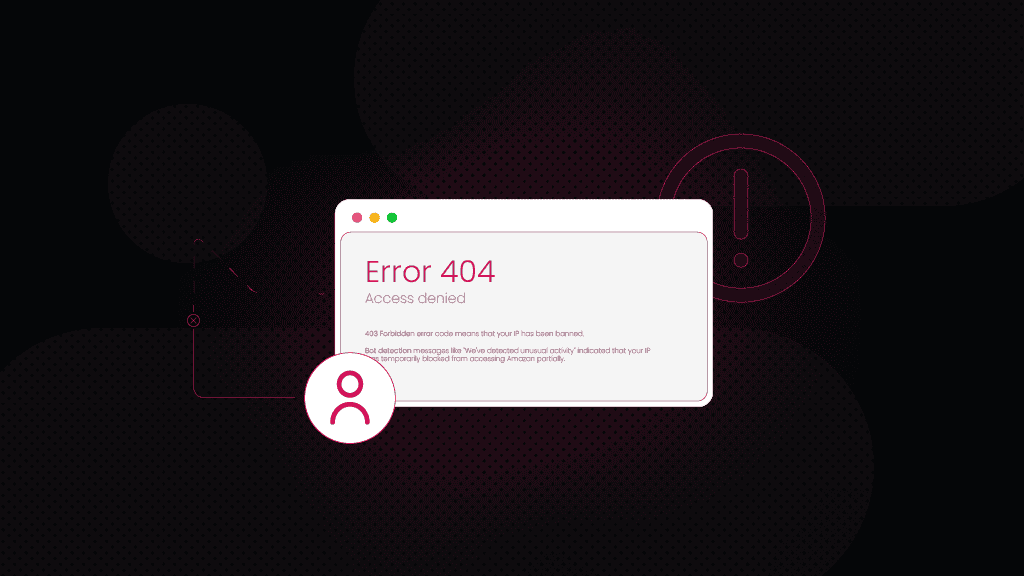IP Ban Error: Your IP Address Has Been Banned [Web Scraping Fix]
Web scraping can be an effective method to gather valuable data from websites, but if performed without the right advanced solutions in place, it often leads to one common problem – an IP ban error. If you've ever encountered the message "Your IP Address Has Been Banned", it means your IP has been flagged, likely due to automated or high-frequency activity. Luckily, there’s a way to avoid this IP ban. We’ll dive deeper into what causes IP bans, how to fix it, and the best practices to prevent from getting blocked in the future.
What is an IP ban error "Your IP Address Has Been Banned"?
An IP ban occurs when a website detects unusual behavior from a specific IP address and blocks it from accessing its services. This error typically appears after repeated violations of a site’s terms of use, often triggered by bot-like actions such as scraping, automated data collection, or third-party integrations plugged into your browser.
Websites that put your IP down prevent you from further access by blocking requests from your IP address. This measure is mainly used to control traffic, especially when they detect scraping bots, which can strain their servers or even extract sensitive information.
What causes an IP ban error in web scraping?
There are a few reasons why your IP address got banned when you were collecting publicly available data from various websites.
#1 Excessive requests
When you send too many requests quickly, websites can detect this as unusual activity and enforce rate-limiting, restricting the number of requests your IP can make within a specific timeframe.
This is commonly interpreted as bot-like behavior, as it exceeds the typical browsing pattern of a human user. Websites often block or throttle IPs that trigger these limits to prevent excessive data harvesting, ensuring their servers remain stable and secure from potential abuse.
#2 Violating terms of service
Many websites enforce strict anti-scraping policies to protect their content, user data, and precious server resources. These policies are often outlined in their terms of service, outlining that automated data collection isn’t allowed.
As a result, websites implement measures like IP bans to tame unauthorized scraping. Depending on the severity of the violation, the ban can be either temporary or permanent. Still, usually, there’s no countdown you can check out to identify how long it’ll take to gain back access to the website, so it’s a guessing game.
#3 Aggressive crawling
Disregarding a site's robots.txt file, which outlines the sections of a website that are off-limits for web crawlers, can result in, you’ve guessed it – IP block. This file is essential for website owners to protect sensitive or resource-intensive areas and to control how their content is indexed.
Crawlers and automated scraping solutions that ignore these rules can overload servers or, if the website is poorly protected, even private data, prompting websites to enforce IP bans as a protective measure.
#4 Detection of non-human behavior
Websites commonly use advanced behavior analysis and browser fingerprinting tools to monitor user activity and distinguish between human visitors and robots. These tools track various factors, such as mouse movements, time spent on pages, or browsing patterns.
When the solution detects non-human behavior, like repetitive actions, identical intervals between requests, or navigating pages faster than a real user would, websites may flag this as suspicious. Usually, if these patterns are detected, the site may block the IP to prevent automated scraping or abuse, ensuring that only real users are accessing the website.
#5 Failed CAPTCHAs challenges
If you’re using a scraping solution that repeatedly fails to solve CAPTCHAs, it sends a clear signal to the server that the activity might be automated. CAPTCHAs are designed to distinguish between humans and bots, and frequent failures indicate that a bot is likely trying to bypass this security measure, triggering the website's anti-bot defenses and flagging your IP as suspicious.
Which websites use an IP ban error?
Many websites implement IP ban errors as a security measure to protect their data and resources. Here's a quick overview of which websites have some IP restriction mechanisms in place:
- eCommerce platforms like Amazon or eBay block automated data collection to prevent price scraping and protect business-sensitive information.
- Social media networks guard themselves against data misuse and violations of the terms of service while also protecting their users’ information.
- News sites protect their copyrighted articles from being scraped and republished.
- Job listing websites block automated data collection to prevent unauthorized scraping of job postings and ensure fair access to job opportunities for all users.
- Travel websites may block your IP to protect their partnerships and ensure users receive accurate, up-to-date information without unfair bot manipulation.
- Financial sites block scrapers collecting market data for trading algorithms.
- Academic databases ban IPs when scraping intellectual property, academic papers, or large volumes of research data.
IP block error in Amazon
On Amazon, a blocked IP doesn’t always come with a straightforward "Your IP has been banned" message. Instead, you may experience signs like CAPTCHAs, slow loading times, limited access to certain pages, or unexpected errors like "Page not found" or "Access Denied". Here are some other errors you might encounter:
- HTTP 503 Service Unavailable indicates the server refuses the request due to IP-based throttling or blocking.
- 403 Forbidden error code means that your IP has been banned.
- Bot detection messages like "We've detected unusual activity" indicated that your IP was temporarily blocked from accessing Amazon partially.
- Blank pages or redirects might be displayed when, instead of an error message, Amazon might decide to redirect your scraper to the homepage or a blank page.
- Connection timeout can happen when Amazon drops your requests due to bot-like behavior.
How to fix an IP ban error?
Sometimes, cleaning the cache is all it takes to fix an IP ban error. However, if you were using an automated data collection solution and Amazon identified it, you might need to try out other fixes:
Solution #1: use proxies
Rotating residential proxies or static residential (ISP) proxies can help you bypass IP blocks. By rotating IP addresses, you distribute your requests over different IPs, reducing the chance of detection. Here’s a quick setup guide on how to plug in proxies:
- Choose a provider that best suits your needs – look at the IP pool size, average speed, and price.
- Get your proxies while also evaluating the proxy IP quality.
- Configure the parameters. Set your authentication method, location, session type, and protocol.
- Copy the endpoints and paste them into your third-party solution, like X Browser.
- Send a test request to Amazon with your proxies to see if your setup works correctly.
Solution #2: slow down your requests
It's important to manage the speed and frequency of your requests to avoid triggering rate limits. Reducing the number of requests per second minimizes the risk of overwhelming the server and getting under the radar of anti-bot software. Some random delays between each request can further help mimic human-like browsing patterns, making your activity appear more natural.
- Limit request rate. Slow down your scraping speed by reducing the number of requests sent within a given time frame. This prevents the server from detecting abnormal, bot-like behavior.
- Use random intervals. Instead of using consistent delays, introduce random intervals between requests. This irregularity mimics the natural flow of human interaction with websites, helping avoid detection and allowing longer scraping sessions without hitting rate limits.
Solution #3: use advanced scraping tools
Using an Amazon scraper with advanced scraping tools can significantly improve your ability to bypass anti-bot mechanisms and avoid IP bans while collecting data from Amazon. These tools often come equipped with sophisticated features designed to mimic human behavior, such as rotating IPs, automatically solving CAPTCHAs, and using headless browsers to simulate real user behavior.
Advanced scrapers can also handle dynamic content like JavaScript-heavy websites, making them more versatile for accessing Amazon and other targets equipped with sophisticated anti-bot mechanisms. Such tools often include built-in options for rate-limiting, request throttling, and incorporating random delays, reducing the likelihood of detection by websites. Additionally, many of these tools offer proxy integration, allowing you to route your requests through different IPs, thus distributing the load and further minimizing the risk of facing an IP error message or, worse, being blocked.
And if you want to stay safe and sound when collecting data from Amazon, use eCommerce Scraping API that conveniently returns results in HTML, JSON, or table format and offers a one-click scraping setup with pre-made templates.

Start scraping Amazon with a 7-day free trial
How to prevent an IP ban error in web scraping
Prevention is always better than cure. Save this checklist for the future when you’re running your web scraping tasks to avoid facing IP restrictions.
- IP rotation – constantly rotate your IPs to make your requests appear to be from different users.
- Proxies – using residential proxies makes your IPs look like they belong to real users, which reduces the chances of being detected and blocked.
- Human-like interaction – implement features that mimic real user behavior, such as auto-solver for CAPTCHAs, using varying User-Agent strings, and adding random delays between requests.
- Scraping tasks – distribute them across multiple servers or regions to avoid overloading a single IP address.
- Robots.txt – always check and respect this file on the website you're scraping to avoid getting banned.
Bottom line
The "Your IP Address Has Been Banned" error is a common obstacle for users who frequently collect data from various websites. Whether it's due to excessive requests or failing to complete CAPTCHAs, some workarounds can help you avoid getting your IP blocked.
Slow down your request rate, use reliable proxies to rotate your IPs, and employ advanced scraping tools that mimic human behavior with random intervals and your scraping journey should continue without interruptions!
About the author

Martin Ganchev
VP Enterprise Partnerships
Martin, aka the driving force behind our business expansion, is extremely passionate about exploring fresh opportunities, fostering lasting relationships in the proxy market, and, of course, sharing his insights with you.
All information on Smartproxy Blog is provided on an as is basis and for informational purposes only. We make no representation and disclaim all liability with respect to your use of any information contained on Smartproxy Blog or any third-party websites that may belinked therein.





